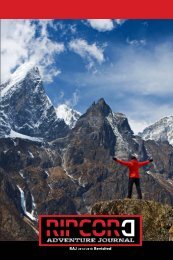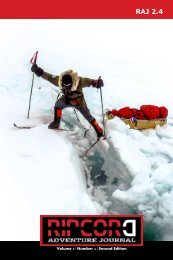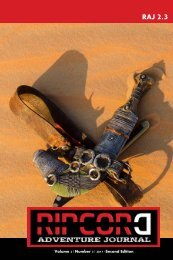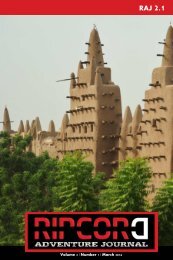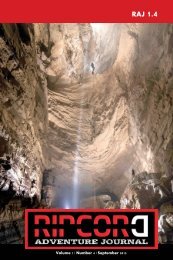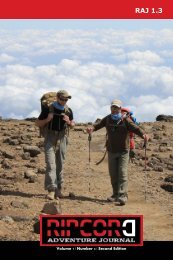Ripcord Adventure Gear Guide #1
Ripcord Adventure Gear Guide is a new quarterly publication with high-quality, authoritative editorial with first hand reviews of adventure gear and provides a comprehensive listing of the best gear in each sector with ratings provided by world explorers who will test the gear in real world situations. We hope that Ripcord Adventure Gear Guide will become the adventure enthusiasts’ almanac.
Ripcord Adventure Gear Guide is a new quarterly publication with high-quality, authoritative editorial with first hand reviews of adventure gear and provides a comprehensive listing of the best gear in each sector with ratings provided by world explorers who will test the gear in real world situations. We hope that Ripcord Adventure Gear Guide will become the adventure enthusiasts’ almanac.
You also want an ePaper? Increase the reach of your titles
YUMPU automatically turns print PDFs into web optimized ePapers that Google loves.
57<br />
Flashback: Mountaineering Boots<br />
The Development of High-Altitude Expedition Boots<br />
were sealed with latex, it created a kind of inner boot, which<br />
worked as vapour barrier. This innovation prevented the insulation<br />
being dampened by sweaty feet, which could have adversely<br />
affected its efficacy. Wet feet would not be a problem so long as they<br />
were kept warm, and so the climbers’ feet were further protected<br />
against the cold by adding a 10mm high-grade felt under sole and an<br />
outsole of the same thickness. The outsole was made from a microcellular<br />
resin rubber with hand-cut lugs.<br />
AAAAAAAAAAAAAAAAAAAAAAAAAAAAAAAAAA<br />
AAAAAAAAAAAAAAAAAAAAAAAA<br />
To offer additional protection against the snow, the boots supplied<br />
with removable rubberised stockinettes. However, they weren’t<br />
strong enough for the task. As expedition member Charles Wylie<br />
wrote, “The thin outer covers proved too weak over this period, and<br />
developed tears and holes through which snow entered and wet the<br />
boot. The Swiss system of a detachable gaiter, as worn by Tenzing…<br />
would be better”. Nevertheless, both the climbing and the highaltitude<br />
boots were designed with a low cut, as this would make it<br />
easier to slip your foot into a frozen boot. Even the lacing holes<br />
were eliminated in favour of ‘D’ rings, as it would make the<br />
tightening of laces easier with frozen fingers.<br />
The boot tests were conducted in the Swiss Alps during December<br />
1952. With a total weight of 1.9 kg, they were a kilo lighter than the<br />
boots used by the Swiss on earlier expeditions. The innovative<br />
design of the SATRA boots not only helped the mountaineers to<br />
conquer Everest, but also saved them from getting frostbite.<br />
Conquering K2 in Deer Fur<br />
A year later, in 1954, the mountaineering world was a witness to yet<br />
another incredible achievement: the ascent of K2 by an Italian team.<br />
The summiteers, Compagnoni and Lacedelli, wore Dolomite kneelength,<br />
high-altitude boots that were made from deer fur with<br />
opossum liners. Equipped with Vibram soles, the boots gave them a<br />
better grip on icy and mixed state surfaces.<br />
Just as the history of mountaineering is full of fascinating stories, so<br />
too is the development of the gear which aided climbers in their<br />
pursuit of the world’s mountain summits. And the development of




